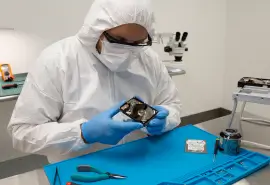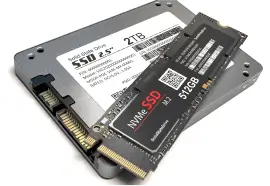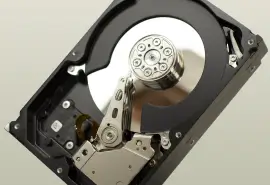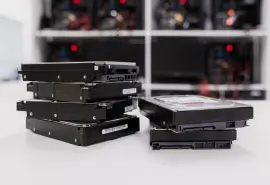The need for external storage has never been greater in digital media fields. Whether you are a longtime videographer or starting as a freelance photographer, the right external drive makes all the difference. External drives can help manage active projects or store backups and archives.
These drives must perform well and safeguard essential data, regardless of their intended use. However, they often have unique features that are suited to different tasks. As a result, choosing an external device can be stressful for creatives who have limited interest in tech.
This guide outlines the key factors to consider when selecting an external drive for photography and videography. Our picks for the best external hard drives and SSDs reflect the best values in terms of real-world performance and reliability.
What To Look for in External Storage
Here are the primary factors to consider when buying an external drive for digital media workflows:
- Storage Capacity: Photographers and videographers create large volumes of data. RAW image files and high-resolution videos can quickly consume storage space. You want an external drive with ample storage space for both current and future projects.
- Performance: The drive’s read/write speed impacts how fast the device can access and save data. This metric is especially vital for editing directly from the drive. Solid-state drives (SSDs) perform much better than hard disk drives (HDDs).
- Compatibility: External drives do not function across all workstations and personal computers. A compatible connection type, such as Thunderbolt or USB-C, and a suitable power supply are required. You might need adapters in some cases. The file system must also support Windows, Mac, or cross-platform use.
- Durability: Rugged drives with resistance to water, dust, shock, and crush can withstand the physical demands of shooting outdoors. They may also need to withstand extreme climates.
- Security Features:Protecting personal or private data in the event of device loss or theft is vital. Encryption can secure sensitive files and build trust among clients.
- Size: Many external drives are portable due to their slim, lightweight design. Still, size can be an issue for location shoots. In those cases, a more portable drive makes fieldwork simpler.
- Cost: Users must decide what aspect is most important to them and balance other factors within their budget. Sometimes, spending extra on a more scalable solution saves money over time.
Researching all options is time-consuming and could take hours from working on projects or growing your business.
That is why our experts offer their recommendations for the best external drives for photographers and videographers, catering to a range of experience and budgets. So you have the confidence to focus on what matters most.
Note: Most of these external drives come formatted in the exFAT file system by default for seamless cross-platform use. We suggest reformatting the device if you do not intend to use the drive on both Windows and macOS. The large cluster size for exFAT could result in wasted space. Using NTFS on Windows or APFS on Macs provides better tooling and more optimized storage. Also, exFAT is not a journaling file system, which can lead to corruption and data loss when transfers are interrupted.
Best External SSD for Most Content Creators: Samsung T9
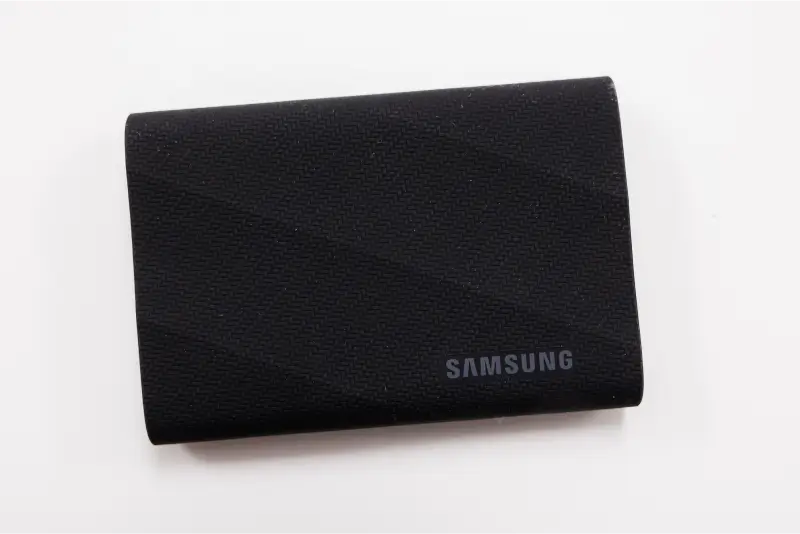
Pros:
- Outstanding read/write speeds for an external drive
- USB 3.2 Gen 2x2 (20 Gbps transfer rate)
- Compact, rubberized frame for drop protection
- Can enable AES-256 hardware encryption
- Comes with Samsung Magician software
Cons:
- Higher price than other models
- Native support for USB 3.2 Gen 2x2 varies
Why We Recommend It
The Samsung T9 Portable SSD is a great choice for digital media pros who work from their external device. Its impressive read/write speeds make editing and production much smoother than similar processes with slower drives. USB 3.2 Gen 2x2 uses two 10 Gbps lanes to achieve data transfers up to 20 Gbps. The upgrade means shorter wait times when transferring files to different storage devices.
Here’s how the Samsung T9 fared when we tested it:
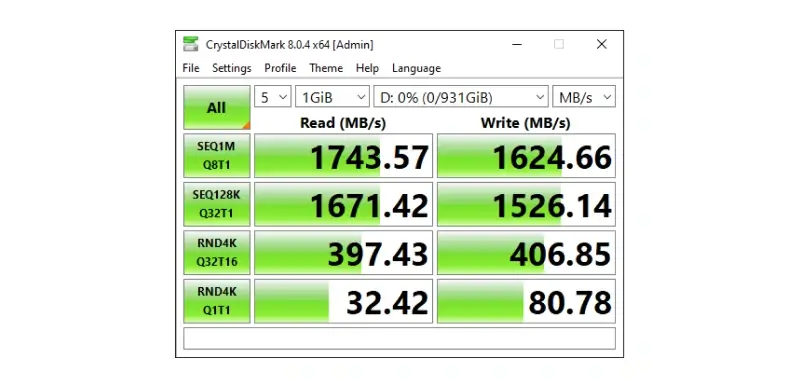
The T9 performed well on the synthetic benchmark from CrystalDiskMark. Although, these workloads do not reveal much about the real-world performance of an SSD. Therefore, we benchmarked it on a random sample of data with various file sizes.
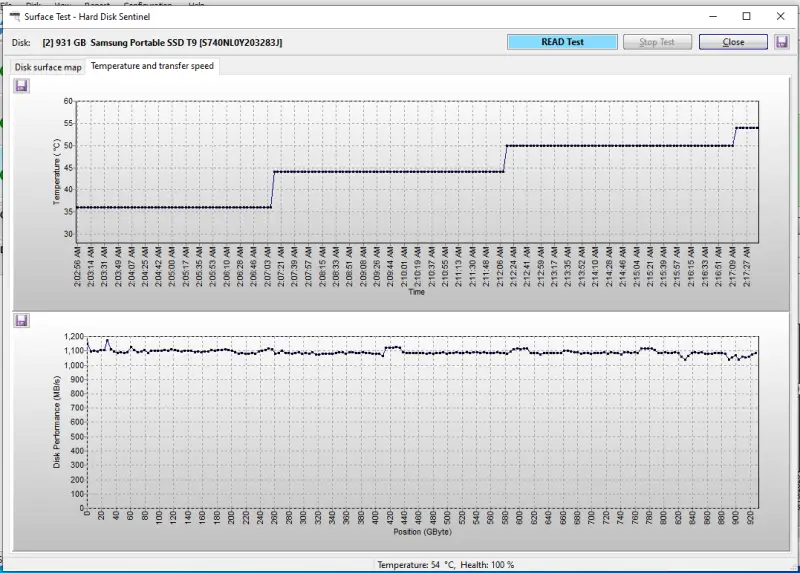

However, not all systems support USB 3.2 Gen 2x2, so performance may vary. The T9 registered the following results with a 10 Gbps connection.
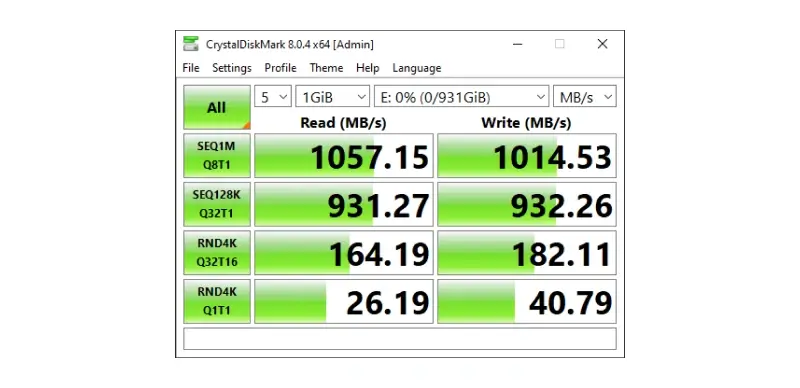
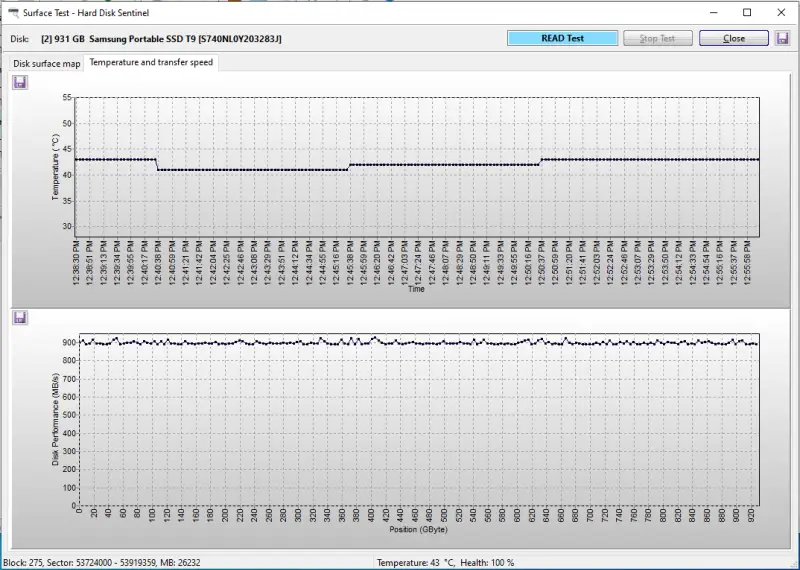
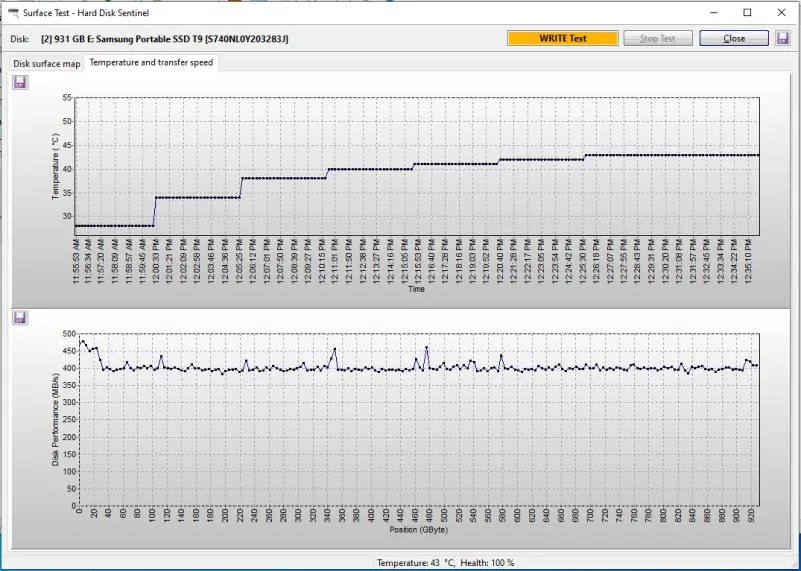
As you can see, using USB 3.2 Gen2x2 impacts the T9’s read/write speeds. You can purchase an expansion card to add USB 3.2 Gen2x2 port to your system if desired. This setup supports 20 Gbps bandwidth and maximizes its potential.
The T9 has a few other helpful features. It boasts a rubberized case for improved grip and offers shock resistance for drops up to 9.8 feet (3 meters). The drive also allows users to enable AES 256-bit hardware encryption. Full-disk encryption will protect stored data from unauthorized access if the device is lost or stolen. Finally, the T9 comes with Samsung Magician software for drive management. This suite includes a range of diagnostic, maintenance, and migration tools.
Despite its higher price tag, the T9 is an excellent option for pros who need pure performance and streamlined features.
Key Specs and Features
| Samsung T9 | |
|---|---|
| Drive Type | External SSD |
| Capacities | 1 TB, 2 TB, and 4 TB |
| Connection Type | USB-C |
| Connection Interface | USB 3.2 Gen 2x2 |
| Bus Interface | PCIe 3.0 x4 |
| NVMe Support | Yes |
| Max Sequential Read Speed | 2,000 MB/s |
| Max Sequential Write Speed | 1,950 MB/s |
| Encryption | AES-256 Hardware |
| Warranty | Limited 5-Year |
Best External SSD for Power Users: Corsair EX400U
Pros:
- Jaw-dropping throughput for an external drive
- USB4 interface (40 Gbps transfer speeds)
- Sustained performance over large transfers
- MagSafe ring for mobile devices or PC cases
Cons:
- Requires a system compatible with USB4
- Lacks hardware encryption
Why We Recommend It
The Corsair EX400U delivers blistering speeds to content creators by using reliable components and next-gen USB standards. The USB4 interface hits 40 Gbps by unifying several technologies within a single cable and port. Those transfer speeds represent a twofold increase over external drives equipped for USB 3.2 Gen 2x2. That dramatic difference makes frequently transferring a high volume of photos and videos much smoother. Benchmarks even reveal that the model maintains its performance over a prolonged period.
Corsair did not stop at designing one of the fastest external SSDs, though. The EX400U has a MagSafe ring that allows users to attach the drive to a smartphone for direct video capture. The convenient ring can also snap onto a desktop case or laptop when shuffling files between devices.
The lack of widespread support for USB4 is the biggest obstacle for the EX400U at this point. Otherwise, it is a superb SSD for pros who demand the most from their external drive.
Note: Looking for a Thunderbolt™ 5 SSD instead of a USB4 drive? The OWC Envoy Ultra has breathtaking speeds, but shares the same compatibility concerns as the EX400U.
Key Specs and Features
| Corsair EX400U | |
|---|---|
| Drive Type | External SSD |
| Capacities | 1 TB, 2 TB, and 4 TB |
| Connection Type | USB-C |
| Connection Interface | USB4 |
| Bus Interface | PCIe 4.0 x 4 |
| NVMe Support | Yes |
| Max Sequential Read Speed | 4,000 MB/s |
| Max Sequential Write Speed | 3,600 MB/s |
| Encryption | No |
| Warranty | Limited 3-Year |
Best External SSD for Hobbyists: Samsung T7
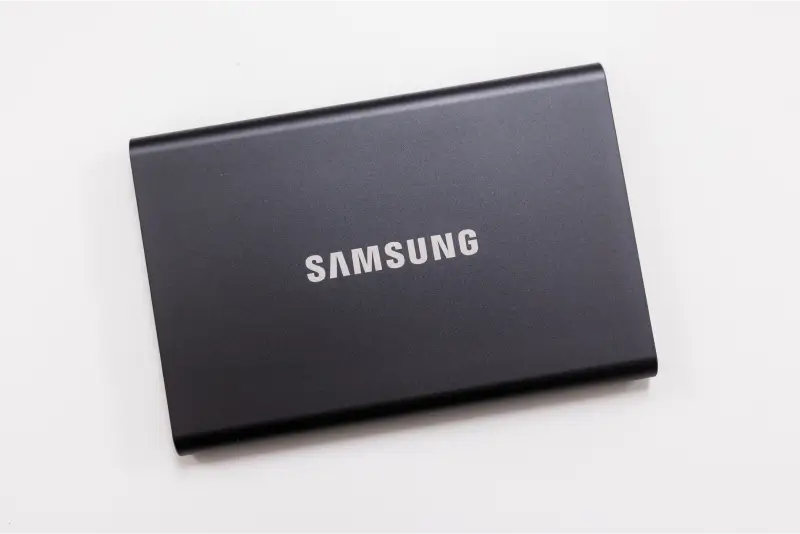
Pros:
- Good read/write speeds for its class
- Sleek, lightweight drive with aluminum case
- Can enable AES-256 hardware encryption
- Comes with Samsung Magician software
- Works with Windows, Mac, and Android devices
Cons:
- Performance can degrade with a full cache
- USB 3.2 Gen 2 (10 Gbps transfer rate)
- Three-year warranty instead of five
Why We Recommend It
The Samsung T7 Portable SSD is the popular precursor to the T9. Not surprisingly, the T7 features many of the same design concepts. It packs fairly fast read/write speeds into a small form factor that does not break the budget. The T7’s metrics meet the needs of most hobbyists or those just starting in the field.
The graphics below show the performance of the T7 on synthetic tests and practical benchmarks:
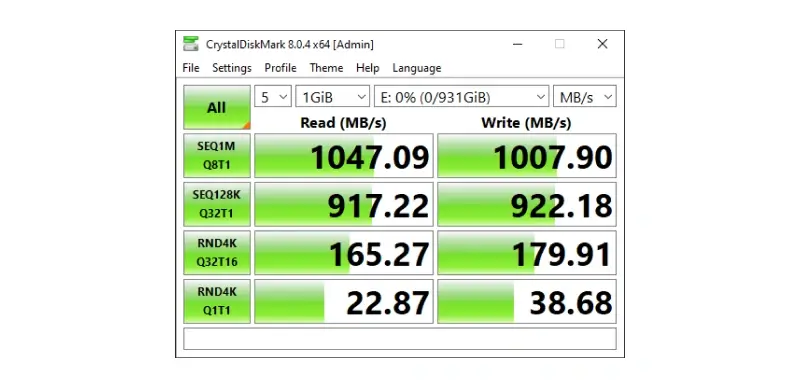
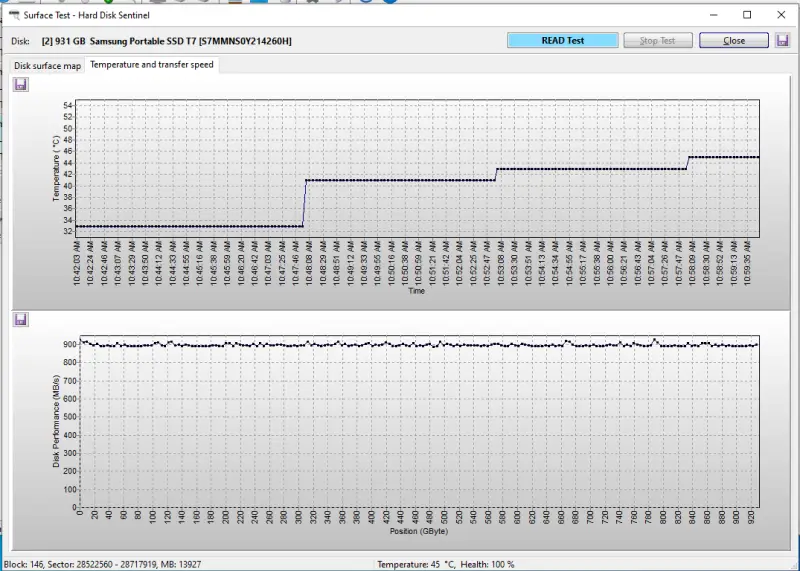
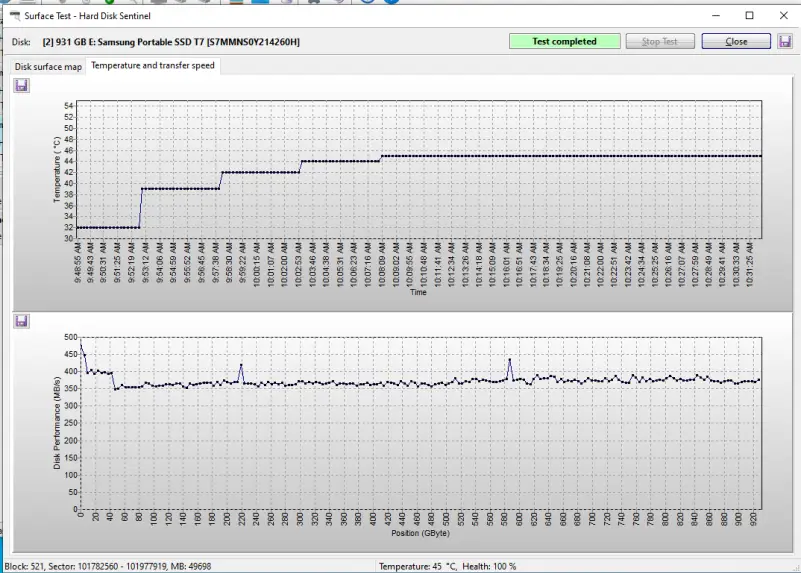
The T7 utilizes triple-level cells for increased density and compensates for the performance loss with a write cache. However, the drive's performance degrades once the cache with single-level cells fills up during sustained file transfers. Using the drive in short bursts or waiting for the cache to clear relieves the bottleneck. Likewise, the T7’s USB 3.2 Gen 2 interface limits its transfer rate to 10 Gbps. These drawbacks might not even affect the workflows of some users.
In addition, the drive is compatible with Android smartphones and tablets via a USB On-The-Go adapter. This support could appeal to creators who frequently use their mobile devices. The T7’s aluminum chassis is rated for drops around 6 feet (2 meters). Like the T9, it comes with hardware encryption and Samsung Magician software to enhance security and ease of use.
Still, the T7 is a budget-friendly external SSD with good performance, making it a tempting choice for hobbyists.
Key Specs and Features
| Samsung T7 | |
|---|---|
| Drive Type | External SSD |
| Capacities | 500 GB, 1 TB, 2 TB, and 4 TB |
| Connection Type | USB-C |
| Connection Interface | USB 3.2 Gen 2 |
| Bus Interface | PCIe 3.0 x4 |
| NVMe Support | Yes |
| Max Sequential Read Speed | 1,050 MB/s |
| Max Sequential Write Speed | 1,000 MB/s |
| Encryption | AES-256 Hardware |
| Warranty | Limited 3-Year |
Best External SSD for Recreational Outdoor Use: Samsung T7 Shield
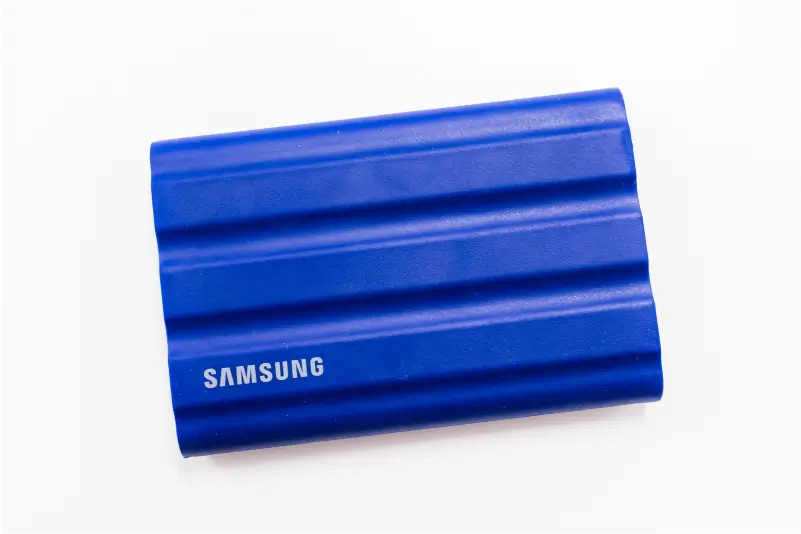
Pros:
- Solid read/write speeds in a rugged package
- Aluminum case shielded by rubber shell
- IP65 rating for dust and water resistance
- Can enable AES-256 hardware encryption
- Comes with Samsung Magician software
- Works with Windows, Mac, and Android devices
Cons:
- Performance can degrade with a full cache
- USB 3.2 Gen 2 (10 Gbps transfer rate)
- Three-year warranty instead of five
Why We Recommend It
The Samsung T7 Shield is another member of the T series of portable SSDs. The T7 Shield builds on the T7’s design to provide content creators with a storage device that performs in the field. The result is a compact, durable external drive for outdoor use. The T7 Shield has a sturdy aluminum case and rubber sleeve. Together, these materials give the drive some shock, dust, and water resistance. The device is rated to survive a 10-foot drop and water jets from all directions. Like its T7 counterpart, it can connect to an Android smartphone or tablet.
As mentioned, Samsung SSDs feature strong hardware encryption to restrict access to sensitive data. They also benefit from having Samsung Magician software to manage the drive.
The T7 Shield also has many of the same limitations as the T7. Its write cache and USB 3.2 Gen 2 standard may slow down file transfers on location. However, depending on the drive’s usage, these issues might not even matter.
In terms of rugged external drives, the T7 Shield has good performance, ample storage space, and a fair price.
Key Specs and Features
| Samsung T7 Shield | |
|---|---|
| Drive Type | External SSD |
| Capacities | 1 TB, 2 TB, and 4 TB |
| Connection Type | USB-C |
| Connection Interface | USB 3.2 Gen 2 |
| Bus Interface | PCIe 3.0 x4 |
| NVMe Support | Yes |
| Max Sequential Read Speed | 1,050 MB/s |
| Max Sequential Write Speed | 1,000 MB/s |
| Encryption | AES-256 Hardware |
| Warranty | Limited 3-Year |
Best External Hard Drive for Archives: Toshiba Canvio Advance
Pros:
- Decent read/write speeds for an external HDD
- Much cheaper storage in terms of cost per gigabyte
- Specialized software for backups and security
Cons:
- Much slower read/write speeds than external SSDs
- USB 3.0 and SATA interfaces restrain data transfer rates
Why We Recommend It
External hard drives offer a fraction of the performance of portable SSDs. Regardless, disks are still solid options for archiving finished or inactive projects. They can also store local backups. Deploying hard drives this way requires users to stay involved, though the Toshiba Storage Backup Software helps.
The Toshiba Canvio Advance is perfect for long-term external storage. The disk offers ample storage space at a sharp discount compared to external SSDs. We tested the performance of the Canvio Advance with 1 TB of small, medium, and large files.
In benchmarking, it registered an average speed of:
- 14 MB/s for small files (about 20 hours)
- 74 MB/s for medium files (about 4 hours)
- 100 MB/s for large files (about 3 hours)
- 45 MB/s for mixed files (about 7 hours)
So, while the Canvio Advance is solid for a spinning disk, its read/write speeds and transfer rate won’t amaze anyone.
Consider a Canvio Advance if you want a cheaper method for storing archives or local backups.
Key Specs and Features
| Toshiba Canvio Advance | |
|---|---|
| Drive Type | External HDD |
| Capacities | 1 TB, 2 TB, and 4 TB |
| Connection Type | Micro-USB |
| Connection Interface | USB 3.0 |
| Bus Type | SATA |
| NVMe Support | No |
| Max Sequential Read Speed | N/A |
| Max Sequential Write Speed | N/A |
| Encryption | Yes |
| Warranty | Limited 2-Year |
Best Desktop Hard Drive for Studios: SanDisk Professional G-DRIVE PROJECT
Pros:
- Massive amount of storage space for studio
- SSD expansion slot unlocks more performance
- Simple workflows
- Works with iPads
Cons:
- Expensive for niche storage
- Cannot match the performance of SSDs
- Preformatted for Macs
Why We Recommend It
The SanDisk Professional G-DRIVE PROJECT is a desktop hard drive that can increase the available storage of a studio. The G-DRIVE PROJECT contains an enterprise-class Ultrastar hard drive from Western Digital. The 3.5-inch disks can reach up to 24 TB. An aluminum enclosure houses the hard drive and an expansion slot for a PRO-BLADE SSD. Once added, the PRO-BLADE SSD boosts speeds, enabling quicker workflows and file transfers.
Nonetheless, a high-end SSD outshines the G-DRIVE PROJECT for active editing and other demanding projects. For that reason, this external hard drive is best suited for archives or secondary storage. You will need to reformat the drive if your workstation runs Windows.
A G-DRIVE PROJECT could be a scalable storage solution if you have room in the budget.
Key Specs and Features
| SanDisk Professional G-DRIVE PROJECT | |
|---|---|
| Drive Type | Desktop Hard Drive |
| Capacities | 6 TB, 8 TB, 12 TB, 18 TB, 22 TB, 24 TB |
| Connection Type | Thunderbolt™ 3 and USB-C |
| Connection Interface | Thunderbolt™ 3 |
| Bus Interface | SATA |
| NVMe Support | Yes (PRO-BLADE SSD Expansion Slot) |
| Max Sequential Read Speed | 250 MB/s |
| Max Sequential Write Speed | 250 MB/s |
| Encryption | No |
| Warranty | Limited 5-Year |
Final Word on External Drives (and Cloud Storage)
Ultimately, the best external drive is the one that serves your specific needs. Data storage is not a one-size-fits-all industry. One photographer may prioritize storage space. A videographer might favor pure performance. Others could be shopping in a different price range. Each pro has a unique criteria. These are our top picks, but another external drive may work better for you.
You could also consider a cloud service for archives and backups instead of an external drive. Given bandwidth and network limits, cloud platforms are not ideal for intensive tasks such as real-time editing. Using local storage is the clear choice for the smoothest process.
Secure Data Recovery is the leader in RAID, SSD, and hard drive recovery. We have decades of experience with all device and failure types. Since 2007, our data recovery services have resolved over 100,000 cases of data loss and recovered billions of files. We know the ins and outs of the data storage industry.



